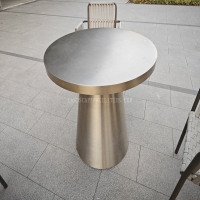Welcome to the website for landscape facilities products and knowledge.
How does the table’s design prevent the transfer of heat or cold to users during extreme weather?
In the relentless battle against extreme weather conditions, modern table engineering has evolved to create remarkable barriers against temperature transfer. The secret lies in sophisticated material science and innovative design principles that work harmoniously to protect users from uncomfortable thermal experiences.
Advanced composite materials form the foundation of temperature-resistant tables, featuring layered constructions that incorporate aerogel insulation or vacuum panels within the table's core. These materials possess exceptionally low thermal conductivity, effectively creating a thermal break between the table surface and its supporting structure. During scorching summer days, these layers reflect and absorb heat before it can reach the user, while in freezing conditions, they prevent cold transmission from the table surface to the arms and hands.
The engineering extends beyond mere material selection. Many premium tables incorporate strategic air gap designs within their framework, utilizing dead air spaces as natural insulators. These carefully calculated voids disrupt thermal pathways, much like double-paned windows in energy-efficient buildings. Some manufacturers even integrate phase-changing materials that absorb excess heat during warm periods and release it during cooler times, effectively moderating surface temperatures automatically.
Surface treatments play an equally crucial role. Specialized ceramic coatings and powder finishes are engineered to reflect infrared radiation while remaining comfortable to touch. The table's geometric design also contributes significantly – rounded edges minimize surface area contact, and strategic perforations in metal components allow heat to dissipate before reaching the user.
Furthermore, manufacturers conduct extensive climate testing, exposing prototypes to temperature extremes from -40°F to 120°F to validate performance. The integration of thermal breaks between different material components ensures that conductive materials like metal legs don't become pathways for temperature transfer. Through this multi-layered approach of material science, intelligent engineering, and rigorous testing, today's tables provide unprecedented comfort regardless of weather extremes, transforming outdoor and indoor spaces into consistently pleasant environments.
Related search:

Recommendation
Outdoor Metal Table - Classic Outdoor Furniture, Stainless Steel Table, Durable and Reliable